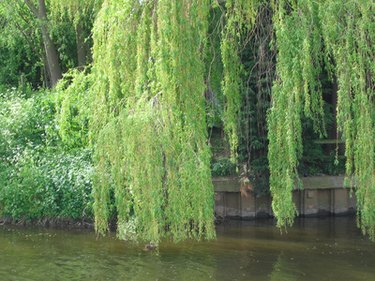
Although weeping willows and other Salix species are susceptible to a variety of insect pests, most are simply an annoyance and will not cause an entire plant to die. Willows that are weakened by a lack of water or other poor cultural practice are much more susceptible to insect infestation and are much more likely to die than healthy weeping willows. Once a tree is seriously infested, knowing which insect is causing the damage may be key to saving an attractive willow specimen.
Carpenterworm
Video of the Day
The carpenterworm (Prionoxystus robiniae) has a wood-boring caterpillar larval stage that is most prevalent near rivers or streams. The caterpillar feeds on the sapwood, leaving visible dark spots on the trunk and expelling recognizable excrement through entrance holes on tree trunks. The larvae are 2 to 3 inches long when mature, are usually greenish-white with a dark brown head and have sharp, hooked legs on the thorax. The larvae can seriously weaken the tree and cause branches to die back. Beneficial nematodes can be used to control carpenterworms.
Video of the Day
Clearwing Moth Borers
Clearwing moth borers cause limbs to die and can be identified by the excrement they push out of tunnels, which sometimes combines with a substance from the tree to become gummy. Larvae are 1 to 1 1/2 inches long and have a dark brown head and whitish body that darkens with maturity. Clearwing moth larvae can cause tree bark to become gnarly and rough and damage the tree's food- and water-conducting tissue.
Larval tunneling can weaken branches enough that they break and fall off, especially in windy conditions. Entire trees can die as a result of infestation. Control clearwing moths with a variety of parasites and predators, including some species of beneficial nematodes. Certain broad-spectrum insecticides can be effective against borers, or physically remove them with a wire probe and prevent their occurrence through good cultural practices.
Flatheaded Borers
Flatheaded borers attack portions of trees that have already been injured and can kill limbs or entire trees. The larvae of metallic adult beetles are light colored and have a distinctive flattened enlargement behind a tiny head. Larvae excavate tunnels under the park that may cause a wet, sappy area on the main trunk that may eventually crack. Prevention and good cultural practices are the most effective management tools for this pest.
Roundheaded Borers
Roundheaded (longhorned) borer adults are medium-to-large cylindrical beetles that often exhibit bright colors. The poplar borer is a common species that attacks willow. Roundheaded borers typically attack already damaged plants. Symptoms of an infestation include bark holes and stains or oozing liquid. Foliage may discolor and wilt and limbs or even entire plants may die. Pesticide applications are not effective in controlling this pest, so proper cultural practice is the best management strategy.
- University of California Statewide Integrated Pest Managment: Carpenterworm
- University of California Statewide Integrated Pest Managment: Clearwing Moth Management Guidelines
- University of California Statewide Integrated Pest Managment: Flateaded Borers
- University of California Statewide Integrated Pest Managment: Roundheaded Borers
- University of California Statewide Integrated Pest Managment: Willow